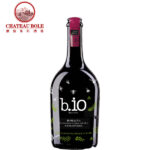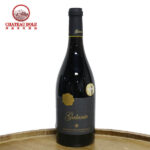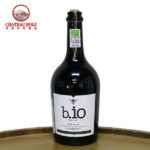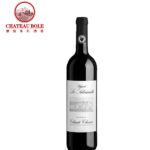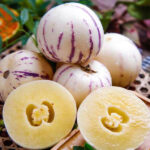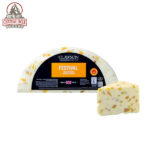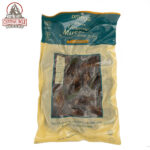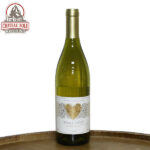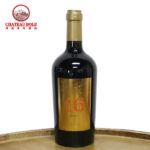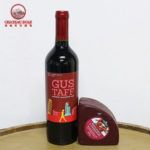Sangiovese
Sangiovese is a red Italian wine grape variety that derives its name from the Latin sanguis Jovis, “the blood of Jupiter”.
Though it is the grape of most of central Italy from Romagna down to Lazio (the most widespred grape in Tuscany, Campania and Sicily. Outside Italy it is most famous as the only component of Brunello di Montalcino and Rosso di Montalcino and the main component of the blends Chianti, Carmignano, Vino Nobile di Montepulciano and Morellino di Scansano. It is also used to make varietal wines such as Sangiovese di Romagna and the modern “Super Tuscan” wines like Tignanello.
Young Sangiovese has fresh fruity flavours of strawberry and a little spiciness, but it readily takes on oaky, even tarry, flavours when aged in barrels. While not as aromatic as other red wine varieties such as Pinot noir, Cabernet Sauvignon, and Syrah, Sangiovese often has a flavour profile of sour red cherries with earthy aromas and tea leaf notes. Wines made from Sangiovese usually have medium-plus tannins and high acidity.
Viticulture
Sangiovese has shown itself to be adaptable to many different types of vineyard soils but seems to thrive in soils with a high concentration of limestone, having the potential to produce elegant wines with forceful aromas. In the Chianti Classico region, Sangiovese thrives on the highly friable shale-clay soil known as galestro.
In the Montalcino region, where there is a high proportion of limestone-based alberese soils alternating with deposits of galestro. The lesser zones of the generic Chianti appellation are predominantly clay, which often produce as high quality of wine as alberese and galestro do.
Wine Making
The high acidity and light body characteristics of the Sangiovese grape can present a problem for winemaking. The grape also lacks some of the color-creating phenolic compounds known as acylated anthocyanins. Modern winemakers have devised many techniques trying to find ways to add body and texture to Sangiovese — ranging from using grapes that come from extremely low yielding vines, to adjusting the temperature and length of fermentation and employing extensive oak treatment.
One historical technique is the blending of other grape varieties with Sangiovese, in order to complement its attractive qualities and fill in the gaps of some of its weaker points.
The Sangiovese-based wines of Chianti have a long tradition of liberally employed blending partners—such as Canaiolo, Ciliegiolo, Mammolo, Colorino and even the white wine grapes like Trebbiano and Malvasia.
Since the late 20th century, Bordeaux grapes, most notably Cabernet Sauvignon, have been a favored blending partner though in many Italian DOC/DOCG regions there is often a maximum limit on the amount of other varietals that can be blended with Sangiovese; in Chianti the limit for Cabernet is 15%.
Wine Regions
While Sangiovese plantings are found worldwide, the grape’s homeland is central Italy. From there the grape was taken to North and South America by Italian immigrants. It first achieved some popularity in Argentina where in the Mendoza region it produced wines that had few similarities to its Tuscan counterparts.
In California the grape found a sudden surge of popularity in the late 1980s with the “Cal-Ital” movement of winemakers seeking red wine alternatives to the standard French varietals of Cabernet Sauvignon, Merlot and Pinot noir.
In Italy, Sangiovese is the most widely planted red grape variety. It is an officially recommended variety in 53 provinces and an authorized planting in an additional 13. It accounts for approximately 10% of all vineyard plantings in Italy with more than 100,000 hectares (250,000 acres) planted to one of the many clonal variation of the grape.
Throughout Italy it is known under a variety of names including Brunello, Morellino, Nielluccio and Prugnolo Gentile. It is the main grape used in the popular red wines of Tuscany, where it is the solitary grape of Brunello di Montalcino and the primary component of the wines of Chianti, Vino Nobile di Montepulciano and many “Super Tuscans”.
Outside Tuscany, it is found throughout central Italy where it places an important role in the Denominazione di Origine Controllata e Garantita (DOCG) wines of Montefalco Sagrantino secco and Torgiano Rosso Riserva in Umbria, Conero in Marche and the Denominazione di Origine Controllata (DOC) wines of Lazio and Rosso Piceno in Marche.
Significant Sangiovese plantings can also be found outside central Italy in Lombardia, Emilia-Romagna, Valpolicella and as far south as Campania and Sicily.
Wines
Wines made from Sangiovese tend to exhibit the grape’s naturally high acidity as well as moderate to high tannin content and light color. Blending can have a pronounced effect on enhancing or tempering the wine’s quality. The dominant nature of Cabernet can sometimes have a disproportionate influence on the wine, even overwhelming Sangiovese character with black cherry, black currant, mulberry and plum fruit.
Even percentages as low as 4 to 5% of Cabernet Sauvignon can overwhelm the Sangiovese if the fruit quality is not high. As the wine ages, some of these Cabernet dominant flavours can soften and reveal more Sangiovese character.
Food Pairing
Sangiovese’s high acidity and moderate alcohol makes it a very food-friendly wine when it comes to food and wine pairings.
One of the classic pairings in Italian cuisine is tomato-based pasta and pizza sauces with a Sangiovese-based Chianti. Varietal Sangiovese or those with a smaller proportion of the powerful, full-bodied Cabernet blended in, can accentuate the flavours of relatively bland dishes like meatloaf and roast chicken.
Herb seasoning such as basil, thyme and sage play off the herbal notes of the grapes. Sangiovese that has been subject to more aggressive oak treatment pairs well with grilled and smoked food. If Cabernet, Merlot or Syrah plays a dominant role, the food pairing option should treat the Sangiovese blend as one of those fuller-bodied reds and pair with heavier dishes such as steak and thick soups like ribollita and puréed bean soup.
Synonyms
Over the years, Sangiovese has been known under a variety of synonyms, many of which have come to be associated with a particular clone of the grape variety. Among the synonyms recognized for the grape are: Brunelletto (in the Grosseto region of Tuscany), Brunello, Brunello di Montalcino, Cacchiano (in Tuscany), Calabrese (in Tuscany), Cardisco, Chiantino (in Tuscany), Cordisio, Corinto nero (on the island of Lipari in Sicily), Dolcetto Precoce, Guarnacciola (in the Benevento region of Campania), Ingannacane, Lambrusco Mendoza (in Tuscany), Maglioppa, Montepulciano, Morellino, Morellone, Negrello (in Calabria), Negretta, Nerello (in Sicily), Nerello Campotu (in Calabria), Nerino, Niella (in Corsica), Nielluccia, Nielluccio (in Corsica), Pigniuolo Rosso, Pignolo, Plant Romain, Primaticcio, Prugnolo, Prugnolo Dolce (in Tuscany), Prugnolo di Montepulciano, Prugnolo Gentile, Prugnolo Gentile di Montepulciano, Puttanella (in Calabria), Riminese, Rosso di Montalcino, San Gioveto, San Zoveto (in Tuscany), Sancivetro, Sangineto, Sangiogheto (in Tuscany), Sangiovese dal Cannello Lungo, Sangiovese di Lamole, Sangiovese di Romagna, Sangiovese Dolce, Sangiovese Gentile, Sangiovese Grosso, Sangiovese Nostrano, Sangiovese Piccolo, Sangiovese Toscano, Sangioveto (in Tuscany), Sangioveto dell’Elba, Sangioveto Dolce, Sangioveto Grosso, Sangioveto Montanino, Sanvincetro, Sanzoveto, Tabernello, Tignolo, Tipsa, Toustain (in Algeria), Tuccanese (in Apulia), Uva Abruzzi, Uva Tosca, Uvetta, Uva brunella, Uva Canina, Vigna del Conte (in Calabria) and Vigna Maggio (in Tuscany).
Showing all 6 results

